Qualcomm’s 8cx Gen 3 for Notebooks, Nuvia Core in 2022/2023
by Dr. Ian Cutress on December 22, 2021 4:30 PM EST
There are many column inches detailing Qualcomm’s design wins and marketing strategy, however to paint it all with a broad brush, it has often boiled down to ‘where can we stick our advanced wireless technology?’. The company has had great success with smartphones, cornering a large chunk of US market and sizeable numbers worldwide, and in the last few years has pivoted to new markets, such as automotive and virtual reality, but also tried to reinvigorate existing markets, such as notebooks and laptops. Since 2017, Qualcomm has wedged a new category into the market, dubbed the ‘Always Connected PC’, offering Windows control with extreme battery life and mobile connectivity. At this year’s Tech Summit, Qualcomm introduced its latest processor, however the real magic might come next year.
Once Connected, Always Connected?
Taking the modern laptop and notebook market as a whole, we’ve seen considerable design improvements over the last 5 years. Gone are the bulky behemoths with poor screens and an hour battery life, replaced by ultraportable devices that can chew through a modern workflow for hours without charge. The sleek designs of this end of the market suit those on the go, most notably academic and business users. On the other end, those bulky designs are now gaming powerhouses supporting virtual reality and immersive gaming – still an hour or two on the battery, but a proper portable workstation.
It’s the ultraportable market where Qualcomm saw an opportunity. Even in 2016/2017, we were seeing designs from Intel and Apple with form factors that made the hardware ideal for the business user on the go. Qualcomm, already established in smartphones as one of the leading players (if not the leading player), identified an opportunity to offer a similar platform in the market, but one bundled with native mobile connectivity, like a smartphone.
Working with Microsoft, we saw the introduction of Windows on Snapdragon based thin-and-light notebooks enter the market in mid-2017, using the previous generation flagship mobile processor. Initial responses to the platform were extremely positive when it came to battery life and as a web-focused work machine that could leverage an independent 4G connection from other devices. Unfortunately the performance, software compatibility, and cost of partner devices from HP, ASUS, and Lenovo were the downsides. For $1000+, users were expecting at a minimum a performance and software parity to their current x86 devices, which this first generation did not provide.
Qualcomm acknowledged the nascent state of the platform – building a version of Windows for Arm (or as Qualcomm puts it, ‘for Snapdragon’, given the close collaboration) is difficult, especially one that also offers emulation of modern x86 software. Identifying the major applications used by customers and working with those software vendors to create ARM native versions, to speed them up, became a Sisyphean task in-of-itself. But on top of this, x86 emulation had been limited to 32-bit for now, eliminating power users from the potential market space. At this time, Qualcomm’s ‘Always Connected PC’ (ACPC) project was focused primarily on business users with typical Office/Web workflows.
The second generation of ACPC used an updated processor, still based on a smartphone design, albeit with more leeway in performance at the higher thermal limits. This Snapdragon 850 generation saw adoption from Microsoft Surface, a big design win for the project. The 850 was the last ‘smartphone designed’ silicon, as from this point on Qualcomm created ACPC specific hardware optimized for notebook use cases – more die area, more graphics, a wider range of thermals. This also accompanied more support for Windows on Snapdragon, however even with the 2020 processor launch of the Snapdragon 8cx Gen 2, there were still software holes to patch and performance for power users still required. But 30+ day standby and 24hrs+ battery made the hardware very attractive.
It was around the Snapdragon 850/Snapdragon 8cx timeframe that Qualcomm realised the ‘value addition’ of mobile connectivity like a smartphone was not the real selling point of the hardware. It was instead the battery – optimizing a smartphone platform for notebooks had significant benefits, allowing users to attend multi-day conferences without the need of a charger (or with the advent of Type-C, one charger for smartphone and laptop). Qualcomm further pushed the commercial credentials of its platform hard.
- Q4 2017: Snapdragon 835
- Q3 2018: Snapdragon 850
- Q4 2018: Snapdragon 8cx (first dedicated for notebooks)
- Q3 2019: Snapdragon SQ1 (faster 8cx for Microsoft)
- Q4 2019: Snapdragon 7c and 7 (cost down versions for education)
- Q3 2020: Snapdragon 8cx Gen 2 and SQ2
- Q2 2021: Snapdragon 7c Gen 2
- Q4 2021: Snapdragon 8cx Gen 3
While the battery life was a big draw, one of the aims of Qualcomm’s ACPC project has been to showcase that having a laptop or notebook with a smartphone like connection enables use cases like no other – the ability to answer email without the need to deal with a small smartphone keyboard, for example, or manage presentations while on the road. For that commercial market, where Qualcomm is selling machines to businesses for their workforce, it makes a lot of sense.
However, there have been other criticisms of that use case, such as the fact that people with a device like an ACPC probably also have a smartphone, and tethering is a thing. The USA was unique for a while in that a number of smartphone data plans disallowed tethering, which would have put a plus on a device like the ACPC with its own connection, however the rest of the world didn’t do this and the USA has seen sense since. A counter to this is the additional battery requirements on the smartphone, which could be a genuine concern.
The other big criticism has come from the wireless carriers themselves – they haven’t adopted the ACPC mindset when it comes to offering applicable plans. In an ideal world, a user would have a single plan covering both smartphone and laptop SIMs and a single data bucket for both, however the carriers that are still charging through the nose for smartphone data haven’t considered the additional use case of a notebook. Some carriers consider ACPCs as tablets (eg a smartphone plan without calls), and end up very restrictive in a similar way. My local carrier wants to charge an additional +50% per month to add an additional ‘data-only line’, but then doesn’t allow me to pool data, requiring micromanagement in 500 MB chunks. In speaking with the carriers in the past couple of months, this way of doing things isn’t going to change soon. The attitude I got was that they’re comfortable extracting significant coin from those willing to pay. On top of that, when focusing to the commercial market, these are company costs and not personal costs, which are less likely to be under the same penny-for-penny scrutiny.
So even though Qualcomm’s marketing focus for the ACPC has shifted slightly, from the connected PC to the all-day workhouse, the goal has always been clear: if we can show that a connected PC becomes a vital component of a company workforce, it’s a customer for life. Once connected, always connected.
My last serious effort to use an ACPC was the Lenovo Yoga C630 WoS, a Snapdragon 850 design in mid-2019. I’ll be honest, the battery life was the biggest plus. It was light, easy to use, and great for events if I needed something just to work, and was guaranteed to not require charging day-to-day. I could be at a 3-day conference on a single charge – a charge I’d done at home before getting on the plane to get there. But there were performance issues, particularly when moving between applications, which I do often and frequently – the 8 GB of memory and 256 GB storage was gazumped on day one. Some of my software had to be emulated, whereas other critical applications in my workflow failed outright, as they were niche 64-bit only software that had no equivalent. Beyond that, Dropbox was limited to Windows S functionality, and the enterprise version of Google Drive wouldn’t even work. That ultimately put me back into the land of x86. Fix those issues, and Qualcomm would rope me back in. This is where the new Qualcomm Snapdragon 8cx Gen 3 fits in.
Qualcomm’s New Snapdragon 8cx Gen 3, with 64-bit Emulation on Win11
At this year’s Snapdragon Tech Summit in early December, Qualcomm announced its next generation ACPC processor, the 8cx Gen 3. With this new processor we should expect more performance, wide availability, but it also comes alongside another significant update. All 8cx Gen 3 machines will ship with Windows 11 as standard, and this version of Windows will support 64-bit emulation of x86 software out of the box. The goal here is that any software a power user needs, it should work on this new generation.
The emulation support on Windows 11 is also regressive for a couple of generations – any system with a Snapdragon 8cx or newer processor will support it. The reason why it’s taken so long, according to Qualcomm’s Miguel Nunes, isn’t so much that the instruction emulation was hard – the hardest part was dealing with the swathes of bad software available in the market. In our conversations with both Miguel Nunes and Alex Katouzian, the culprit restricting the roll-out was bad software – software that calls unregistered DLLs, or are hardcoded to certain 32-bit directories despite being 64-bit, or software that loads beta libraries and such. Qualcomm says that this is now in a predominantly solved state, and we look forward to testing.
(Some might wonder if Windows 11 had anything to do with it, but Qualcomm told us it didn’t. There was an insider version of Windows 10 that also has full emulation, but the idea have a holistic cut between Windows 10 and Windows 11 makes supporting the feature a lot easier we are told. All 8cx and newer hardware is Windows 11 compatible, with the only question being whether users will actually bother to upgrade. Personally I think this delineation, if it does help managing updates to the feature, is likely a good move to avoid long term technical debt across two versions of Windows.)
As for the new processor, the Qualcomm Snapdragon 8cx Gen 3 is heralded by the company as the first 5nm processor to support Windows. I think they’re correct in promoting that statement, which incidentally is printed alongside two significant datapoints: Up to 85% faster CPU and +60% GPU over the previous generation. Those are big jumps.
At the heart of the 8cx Gen 3 is a 4+4 core design, featuring four Arm Cortex X1 cores at 3.0 GHz and four A78 cores at 2.4 GHz. Compared to the previous generation, this is +2 generations of Arm core for performance and a different tier entirely for the efficiency core.
| Snapdragon ACPC Silicon | |||||
| AnandTech | SD 835 |
SD 850 |
8cx Gen 1 |
8cx Gen 2 |
8cx Gen 3 |
| Node | 10LPE | 10LPP | N7 | N7 | 5nm |
| Prime Cores | 4 x A73 2.60 GHz |
4 x A75 2.95 GHz |
4 x A76 2.84 GHz |
4 x A76 3.15 GHz |
4 x X1 3.00 GHz |
| Efficiency Cores | 4 x A53 1.80 GHz |
4 x A55 1.80 GHz |
4 x A55 1.80 GHz |
4 x A55 1.80 GHz |
4 x A78 2.40 GHz |
| GPU | Adreno 540 710 MHz |
Adreno 630 710 MHz |
Adreno 680 585 MHz |
Adreno 690 660 MHz |
Adreno 8cx Gen 3 |
| AI | Hexagon 682 | Hexagon 685 | Hexagon 690 | Hexagon 690 | Hexagon 8cx Gen 3 |
| Total TOPs | - | 3 | 9 | 9 | 29 |
| LPDDR4X | 2 x 32-bit 3733 MT/s 29.9 GB/s |
4 x 16-bit 3733 MT/s 29.9 GB/s |
8 x 16-bit 4267 MT/s 86.3 GB.s |
8 x 16-bit 4267 MT/s 86.3 GB/s |
8 x 16-bit 4267 MT/s 86.3 GB/s |
Whichever way you cut it, moving from A76 to X1 on the performance cores and A55 to A78 on the efficiency cores is a jump, and that ‘up to 85%’ CPU performance sounds like a good metric. Alongside these numbers, the chip also comes with a 14 MB total cache structure, which is 8 MB of L3 cache and 6 MB of system cache, the latter of which is used more as a DRAM buffer to accelerate quick accesses.
Unfortunately Qualcomm was near silent on its new Adreno implementation, to the point of also refusing to give it a designation. On top of this, it is worth noting that Qualcomm doesn’t actually list what the architecture cores in any of its public materials – it wasn’t until a Q&A session at the Tech Summit when the cores were actually given, and only when the explicit question was directly asked. It seems this was accidental, as we didn’t get the details even in a 1-on-1 briefing. The frequencies were part of the presentation, but briefly. With this in mind, combined with the lack of generational numbers on the Adreno and Hexagon moving forward, it seems that Qualcomm is entering a phase of obfuscation when it comes down to disseminating its hardware specifications. If you’ve heard this story before, it’s very reminiscent of Qualcomm pre-2016. Part of this is down to, or at least as we see it, a new marketing strategy where the company is focusing more on ‘the experience’ rather than the technical details. It does feel stretched that this information wasn’t part of the presentation, not even as an auxiliary side note, as part of the Qualcomm ‘Tech’ Summit. For every company that states they’re focusing more on the experience than the specifications, my reaction is very poor – a large portion of our audience, either engineers, power users, enthusiasts, or financial analysts and those looking to disseminate the direction of the industry wants to know these things. Not everything revolves around what a potential end-user, such my grandma, a potential end-user, might experience, even if the more public-facing marketing is directed that way.
Qualcomm is claiming that the SoC offers +25% performance at 25% lower power than the x86 competition, with a 60% better performance-per-watt on CPU and 40% performance-per-watt on GPU. Exact metrics weren’t disclosed, but Qualcomm did point to software such as Adobe Photoshop and Lightroom which have now been optimized for Adreno on Windows. On top of these numbers, Qualcomm is quoting 30% better battery than competing platforms, which for a 16hr flagship Intel device would put it at 22 hours. In my mind that feels like a slight regression, which might be indicative that the A78 cores in idle consume more power than the A55 cores did, even with the process node improvement. At that level, other hardware comes into play as well, such as the display and wireless connectivity.
For wireless connectivity, the 8cx Gen 3 has built in Wi-Fi 6E through the FastConnect 6900, but also a range of 5G solutions: either the X65 at 10 Gbps DL, the X55 at 7.5 Gbps DL, or the X62 at 4.4 Gbps DL. On first reading, this sounds like there are three silicon designs, one for each modem. However I suspect we’re dealing with a single silicon design, and the modem delineations are merely a function of what license the OEM is willing to pay combined with whatever RF front end circuitry the OEM is also willing to pay for. For a cost down device for example, the X62 at half speed might be better suited, or for markets where X65 offers no additional value it might make sense to enable an X55 variant instead.
Other functions include AI acceleration, which Qualcomm is quoting a 3x boost from 9 TOPs to 29 TOPs in the new chip. Note that this is CPU+GPU+Hexagon combined, which is unlikely to exist within the same software – speaking to Qualcomm, they say that different software can use different segments to get good asynchronous performance. The AI is set to be used for camera and video live processing, as well as echo cancellation and noise suppression. It’s clear that Qualcomm want to rival something like RTX Voice but in a much lower power envelope. One of my criticisms of RTX Voice is that I can’t process pre-recorded audio through it without a full play-back and a feedback loop, so when asked, Qualcomm confirmed that content creators will be able to post-process video and audio for noise cancellation.
On security, the 8cx Gen 3 will be the first Windows-focused processor with built-in Microsoft Pluton. Pluton is a superset of traditional TPM features, enabling root-of-trust and firmware authentication, potentially augmented with Microsoft Cloud based environments. I’d be remiss if I didn’t state that since the announcement, there have been some deep criticisms of Pluton as a fundamental concept, tying it to an operating system vendor, and being a potential single point of failure for personal privacy depending on how it is implemented, especially outside the US. All the major Windows silicon companies are committed to hardware-based Pluton solutions long term, so it depends how much you consider these criticisms are valid, inevitable for the wider populace, or something that can collectively be addressed. On top of Pluton, we also have Layered Secure Boot, real time memory encryption, and Qualcomm’s Trusted Execution Environment.
We should expect to see 8cx Gen 3 hardware come to market early next year. However, the big story is yet to come.
Qualcomm x Nuvia, Sampling 2022, Hardware 2023
In March 2021, Qualcomm acquired Nuvia, a server CPU startup working on its first core design. Nuvia’s lead engineers herald from the silicon design teams at Apple and Google, with the lead architect having been the lead architect at Apple during its M1 development phase. Qualcomm acquired Nuvia with the goal of creating hardware to not only compete, but demolish, the Windows market of its incumbents.
At the time of the acquisition, the messaging was that the server core Nuvia was designing would be repurposed for Qualcomm’s ACPC efforts, with silicon due in 2022 for products in 2023. The company reiterated that same timeline at its Analyst event in late November, and at the Tech Summit. When speaking to whether the Nuvia team were creating a single performance core, a series of cores for performance/efficiency, or the key parts of the SoC, I didn’t really get a straight answer. That was perhaps to be expected, given that we’re still almost a year away – I suspect one of the Tech Summit December 2022 highlights next year will be this new Nuvia chip. However it does look like that Nuvia is initially making a single core for the first iteration, relying on regular Cortex designs if the SoC is going to be a heterogeneous design (we expect it will be).
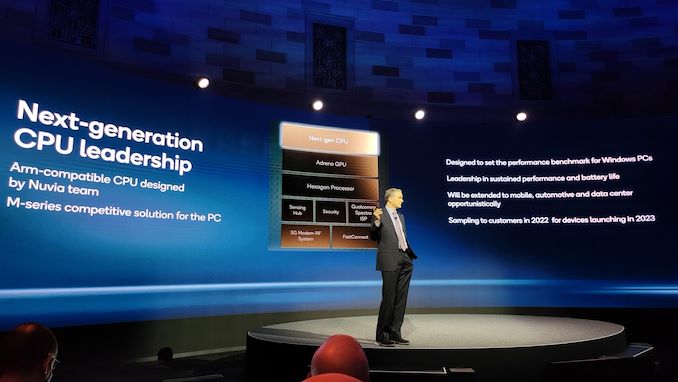
Image from @anshelsag on Twitter, Used with permission
With a lot of hype about Nuvia and the credentials of the team behind it (I apologize, I’m probably responsible for an amount of that hype), we are in this sort of limbo state waiting for the fruits of that acquisition to come through. The 8cx Gen 3 will be a good platform showing an uptick in performance and leveraging 64-bit emulation on Windows 11, but the expectation is that Nuvia’s core design will amplify that performance up another step. Exactly where it will fit compared to Intel or Apple is really hard to say at this point, and we’re going to have to wait to next year. Which makes recommending an 8cx Gen 3 platform in 2022 difficult given that on every review, we’ll have to write a caveat of ‘watch out for the Nuvia designs coming 2023’.


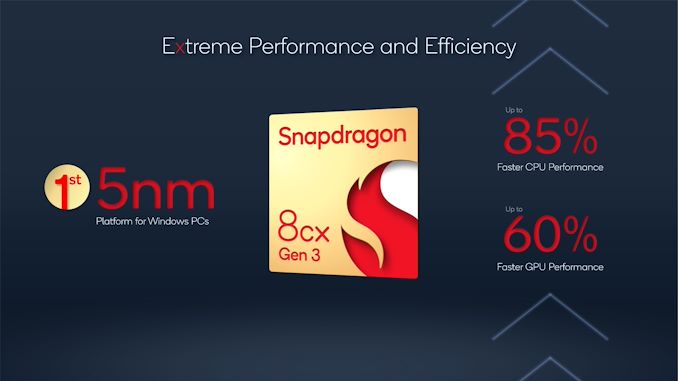
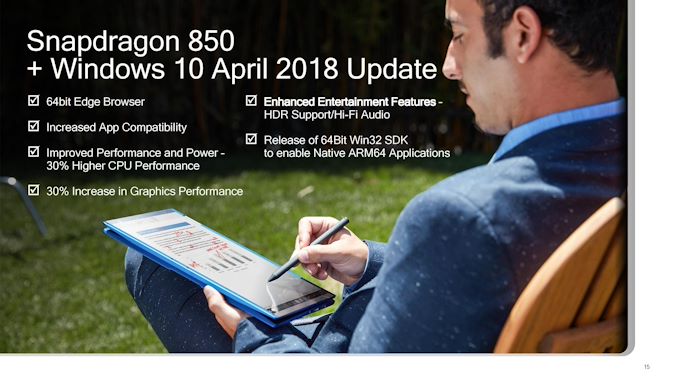

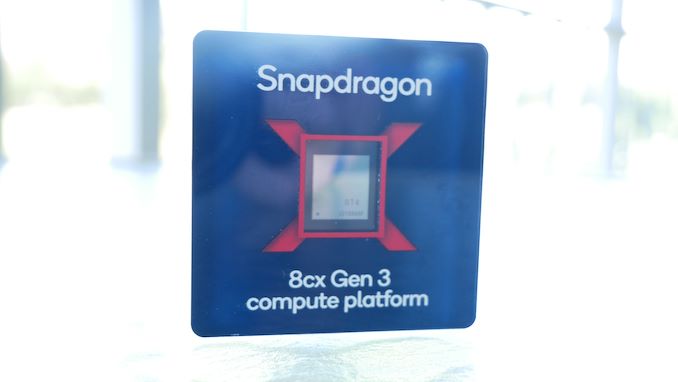
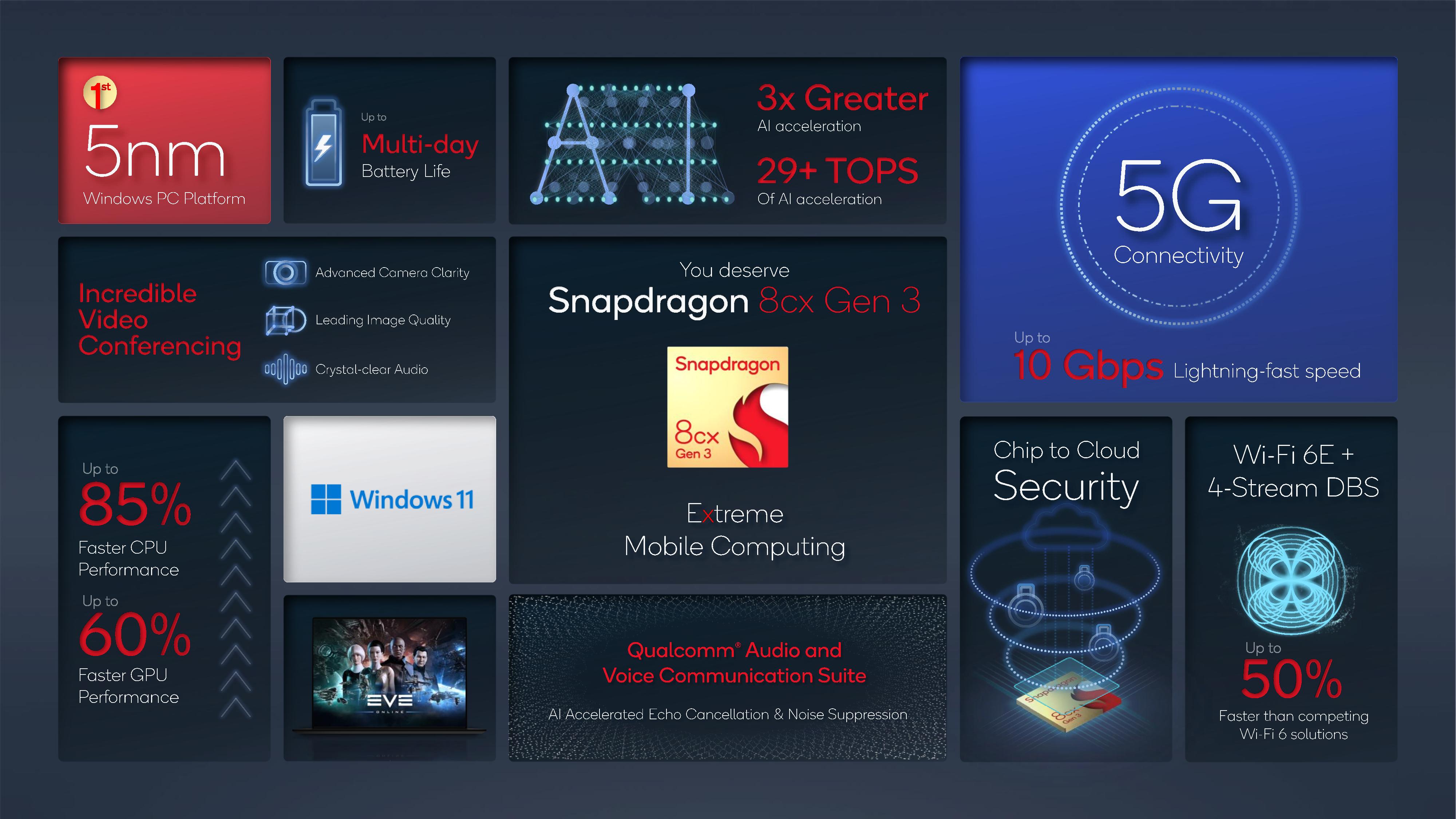
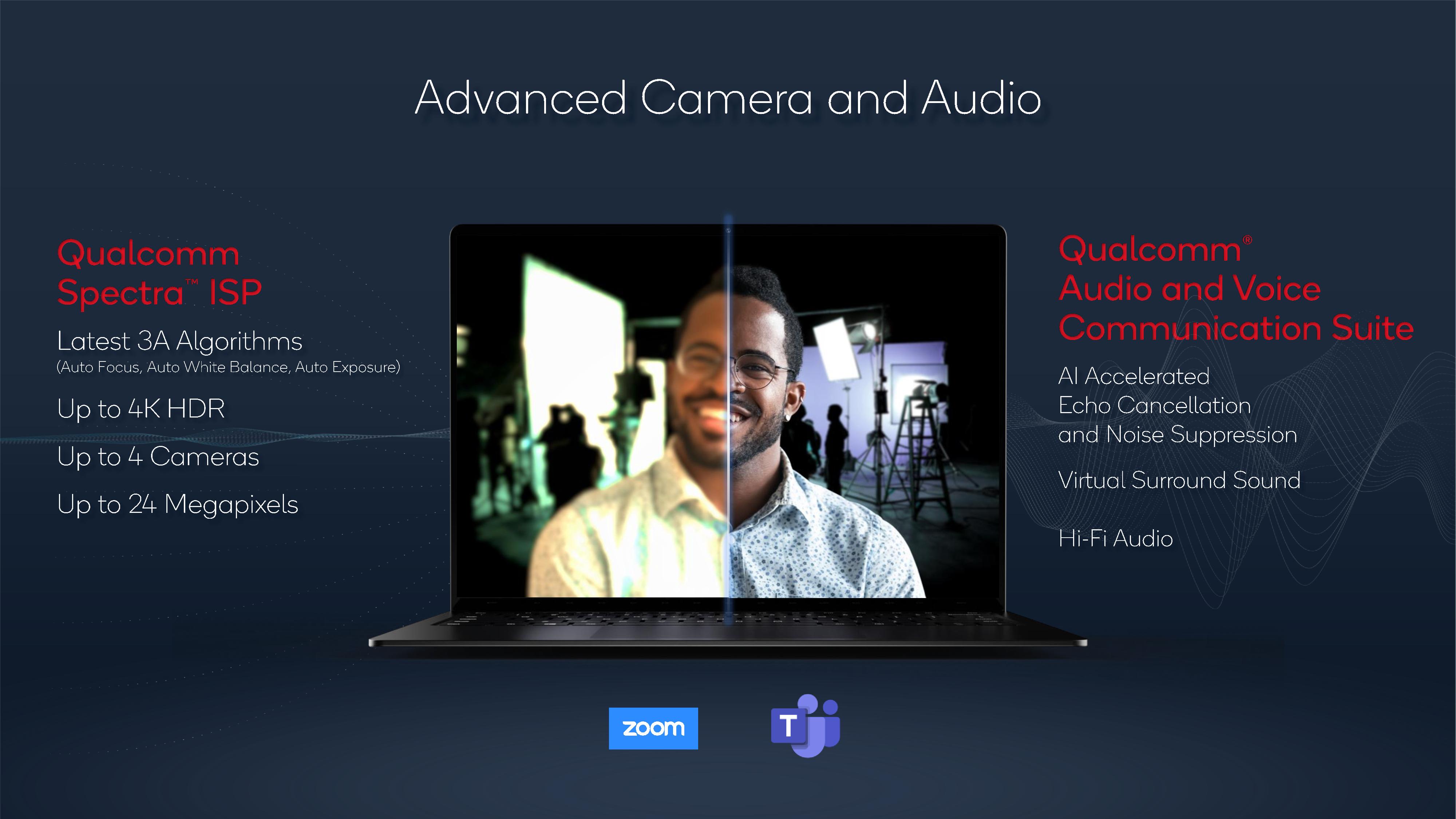








39 Comments
View All Comments
Silver5urfer - Wednesday, December 22, 2021 - link
ARM is what going back to cave is = Locked down BGA soldered everything from NAND SSDs to WiFi, to the damn BIOS. There's no BIOS at all for these Qcomm parts. Apple's ARM processors and their Macs are too niche and their customization is zero. PC x86 Hardware is what evolving from the era of caveman. Keeping consumer in the dark is Apple's speciality. Same for Android OS now, with a lot of API blocks, AAB bundles, Blacklisting APIs, Storage API locks, HW Attested Safety net. To make things worse the Baseband blobs and other packages plus GNU GPL v2 based violations and warranty voids.On windows machines, non surface products. User can control most of the basic stuff. A small program like XTU lets user control every thing. You wanna talk something that is remotely even possible on any ARM device ? Adreno Control Panel is what Qcomm's new reveal is. However Adreno is nothing in front of RDNA2 or Ampere. There's no contest. Apple's own GPU got destroyed in 3D benches by a mere 3060L vs M1 Max (Check Anandtech's review). Their power only shows in dedicated compute IP blocks like Adobe first party optimization.
iphonebestgamephone - Thursday, December 23, 2021 - link
Nono, i was talking about the spying tech in everything.flyingpants265 - Saturday, December 25, 2021 - link
... Yeah?Alexvrb - Sunday, January 2, 2022 - link
He probably has an Android device in his pocket too. :PChrisGX - Wednesday, December 22, 2021 - link
1. There is no such thing as ADL 11400F. The Intel Core i5-11400F is a Rocket Lake part that lacks a GPU.2. You can add the new ARC iGPU to some new Intel part but not the Intel Core i5-11400F. To talk in that way is ridiculous.
3. The Core i5-11400F performs well but it isn't a CPU that can be used in the same contexts as the Snapdragon 8cx Gen 3. The Snapdragon SoC is very obviously meant for relatively low power laptops and comparing it to the Core i5-11400F is absurd. And, you pay an energy cost for the performance of the Core i5-11400F--65W TDP (before factoring in the unavoidable additional energy cost for the dGPU required to complement the bare bones 'F' part).
4. In Perf/W terms it is the Core i5-11400F that gets slaughtered by the Snapdragon 8cx Gen 3. Perhaps some unnamed Intel part might fare better. For the record, though, the Apple M1 slaughters the Core i5-11400F in every way.
5. No doubt, Qualcomm will try to get top dollar for its new compute SoC. And, no doubt, there will be customers for laptops equipped with the Snapdragon 8cx Gen 3. If Qualcomm wants to ride on coattails of Apple's successful transition to ARM it is going to have to price its compute SoC sensibly.
Silver5urfer - Wednesday, December 22, 2021 - link
It was a typo ADL means Alder Lake that's how Intel calls them just like SKL, KBL, CFL, CML, RKL, ADL. It's easy to get that, 12400F is what I mean. You couldn't understand that ?And that thing destroys 5600X at 65TDP since it's not K and locked chip on top cTDP is configurable which is what I mean. M1 doesn't slaughter anything mate, that garbage to destroyed by cheap BGA parts. M1 Pro is what I meant and Pro / Max SKUs start at $2000 price tag. For that cash you can get a 11800H based Laptop and a strong dGPU as well.
ChrisGX - Thursday, December 23, 2021 - link
Yes, I know what 'ADL' means. You are the one who is confused not me. Regarding the Core i5-12400F it has all the shortcomings I previously mentioned and its power requirements are going up! Even with a 15 - 25% performance increase over the Core i5-11400F (which is probably where things will fall) the Core i5-12400F will still offer energy efficiency that is atrociously bad.In case you haven't worked it out yet the Core i5-12400F would be a very poor choice for a laptop anyway, mate, because its a desktop processor! But, I guess we are talking about the Core i7-11800H now because, well, just because. That CPU is designed for laptops, thank goodness, and it is rated at 45W TDP. Phew...only twice the power consumption of the Snapdragon 8cx Gen 3 or M1! And only USD$395. How can anyone fail to be attracted to that?
jayfang - Thursday, December 23, 2021 - link
What percentage of people swap CPU's? A Chromebook may never suit yourself, but they do suit millions of people. Think of Chromebook experience with Windows compatibility. Speed is nice, but not even critical.Just because "not fit for you" does not mean "not a great product".
I've got both a Chromebook and a self-build built Linux workstation. Two different use cases & super happy with both devices. Chromebook on Snapdragon 8cx Gen 3 would be a win.
SoftwareEngineer - Thursday, December 23, 2021 - link
If this is anywhere near the 85% CPU performance this will compete with 15Watt parts from AMD.The truth is most of your argument is "PC Master Race" whining. I've "Built" computers from the time when you PCs needed external cards for Drive controllers, Ports, ethernet, etc, etc... Integration is a GOOD THING. It's nice not needing to add 5 different cards to just get a basic system up and running.
Plus, these are LAPTOP parts. NOT desktop...
Whining about them being "SOCs" is just a bit silly. AMD rolled the IO die into their APU series. APU is just another way of saying SOC. The SPECIFIC reason given by AMD is you make monolithic APUs (SOCs), with higher levels of integration, is to reduce the power consumption caused by chip-to-chip communication. It takes more power to drive a signal off package to another chip/chiplet and laptop designs primary goal is manageable power consumption. It would be nice to have a 5950 in a laptop, but it's not really going to be a practical "laptop", it's going to be more of a portable desktop with a sub 2 hour battery life and bad temperature performance.
These Qualcomm Part are fine for the average office worker who needs to run Word, Excel, Power Point and Outlook. And way overkill if you do most of your work over an RDP or ssh connection to a server. I used an old junk desktop I salvaged from the IT department so I could work when my main system was down. If all you care about is gaming performance, they aren't for you. They are for the person who spends an hour commuting and needs to get work done while he's travelling. And the always online feature is also important when you're on call 24/7 for server maintenance. It sucks to have to rush to find the nearest coffee shop to login to a VPN so you can RDP into a server. The main problem with the Qualcomm based laptops has been price. This is where AMD absolutely dominates. Qualcomm wants top dollar for 20+ hour battery life, but most people are going to plug their laptop in when they go to sleep, so 20+ hour battery life is only so useful.
If you're worried about "Being spied on" while you're using your computer, then maybe you shouldn't be trolling internet post? I personally know from working in a data center, we logged all traffic for all Emails, Webchats and phone calls into and out of the data centers on 5 different continents. You are being tracked, especially if you are commenting on a BLOG.
caribbeanblue - Friday, December 31, 2021 - link
Please, shut it for the love of everyone.